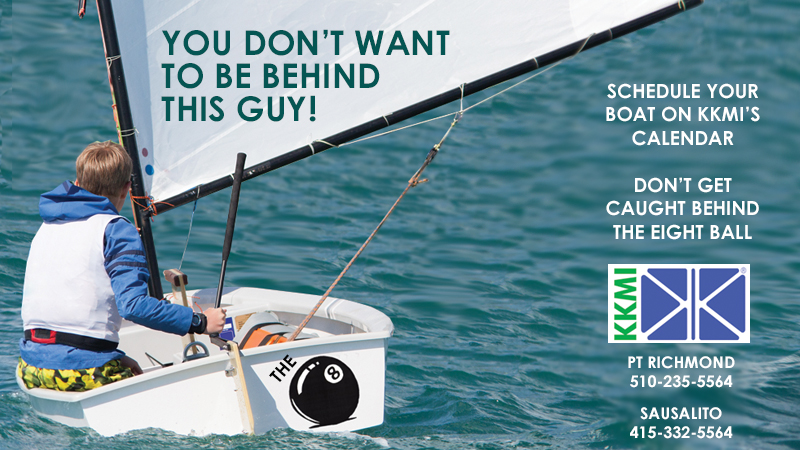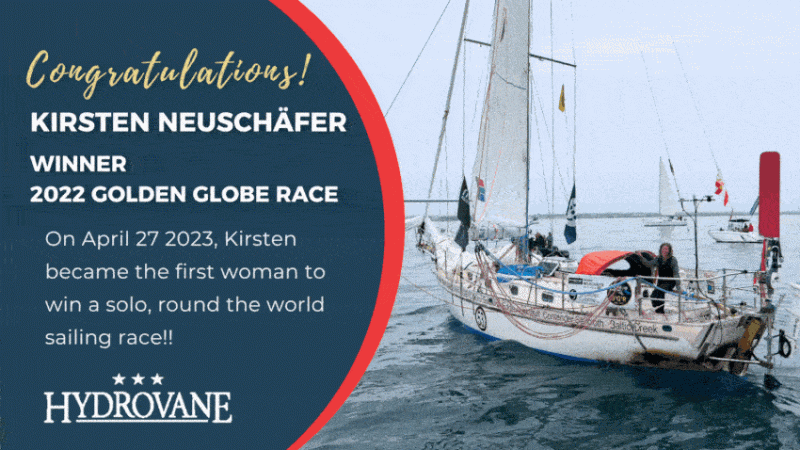
More Footage of the Aussies’ SailGP Wing Collapse
The SailGP weekend in San Francisco was filled with the typical thrills and spills. What we weren’t expecting was the moment when the Australian team’s entire wing collapsed and came crashing down to the waterline. Fortunately, no one was hurt. But the question of what happened remains.
Meanwhile, we’ve been seeing various video clips of that exact moment when the Aussies’ San Francisco podium hopes fell away. We thought you might like to see the clips.
The aerial view posted by SailGP:
The “We’re comin’ at ya!” view, posted by Australia SailGP Team:
And the slow-motion version, also posted by Australia SailGP Team:
We haven’t yet learned what went wrong; we expect the SailGP jury is still deliberating. Australian skipper Tom Slingsby told Nine Wide World of Sports it was all “a bit of a blur.” Perhaps time will tell.
Transpac Profile: Greg Dorn and ‘Favonius 2’
Favonius 2 is the extension of a dream to pursue competitive offshore sailing in its purest form. My journey started with a Jeanneau 39 family cruiser that I raced with a few of the current crew in various short-distance offshore races. As it became increasingly clear that a higher-performance boat would be required to pursue the longest West Coast offshore races, I chose the cruiser/racer hybrid that is the Dehler 46 (Favonius) with a performance carbon rig and keel. The boat performed admirably in its class in two Cabo races and two Transpacs (both ’21 and ’23), including a number of inshore races. We pushed that boat to its limits and it is through the process of reaching Favonius’ potential that I realized we needed a fully dedicated no-compromise racing platform.
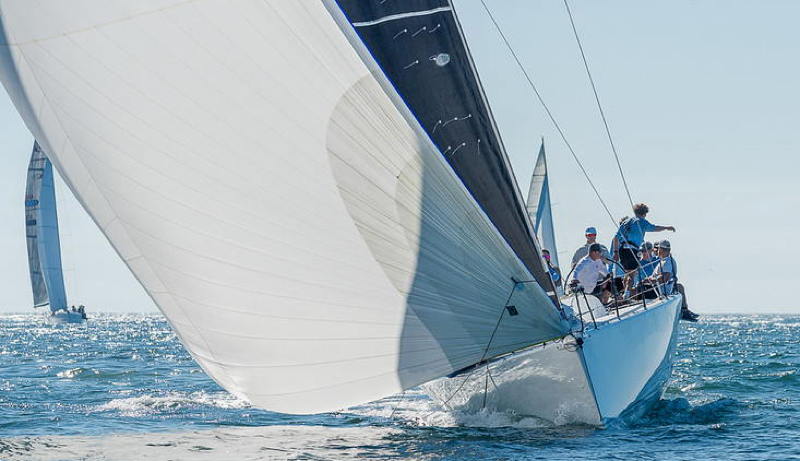
After much analysis I settled on a 2006 Cookson TP52, which had an excellent reputation. We named her Favonius 2 to emphasize the racing journey we are on, as this is our second evolution. Many of the crew moved from Favonius (aka F1) to Favonius 2 (aka F2). We spent the majority of 2024 fitting out and learning F2. And as is well known to all experienced owners and program managers, the fitting out and upgrading of the platform was much more extensive than anticipated; also, we broke things. I was not discouraged by the additional improvements and repairs required because by fully upgrading, breaking and fixing, and servicing the vast majority of the systems, we will now have a boat that is ready to go for the 53rd edition of the Transpac.
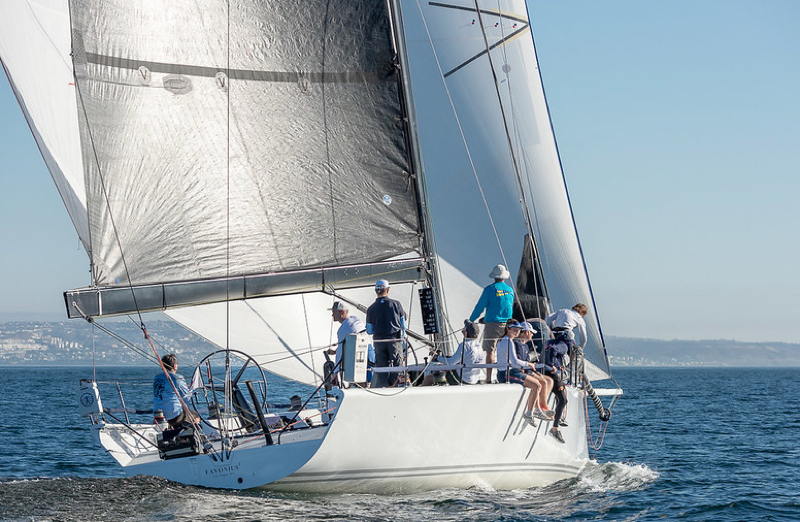
The next stage in our team journey will be sailing the boat to its potential. I have every intention of racing this boat for many years, and so we are targeting 2027 or even beyond to reach the highly competitive level of offshore boat handling we expect of ourselves. We are focused on process, and it is through the rhythms and rituals of sailing that we intend to drive the boat to its potential. Our key principles are excellent team dynamics, deft handling, highly reliable systems, and robust safety protocols. There can be no rushing the journey toward the outer frontier of TP52 offshore performance, and I hope the F2 campaigns become personally revelatory for all involved.
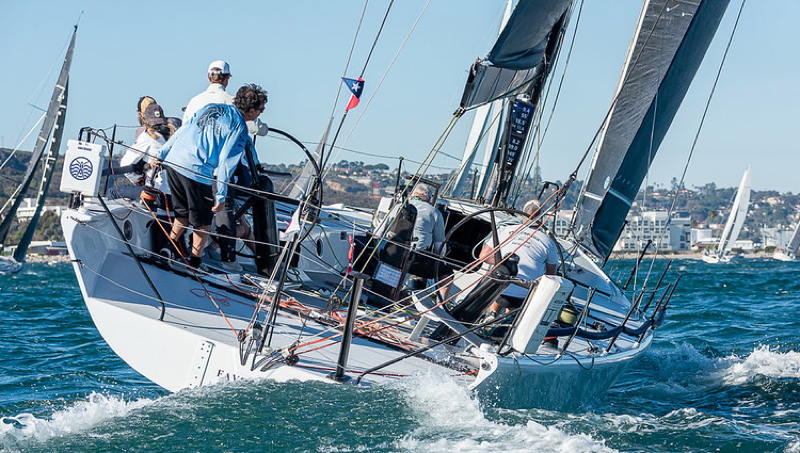
The current crew heading to sail with Favonius 2 for Transpac includes: skipper/owner, Greg Dorn (SFYC/ StFYC); bow, Nick Dorn (SFYC/StFYC); trimmer, Matthew Sessions (SFYC); pit, Cam Tuttle (SFYC); trimmer, Ryder Easterlin (StFYC); trimmer, Rowan Fennell (SFYC); boat manager, Ashley Perrin (SFYC); helmsman, Merf Owen (SFYC); mast, Jared Lathrop (Willamette Sailing Club, Portland. OR); and tactician, Sylvain Barrielle (UK Sailmakers).
Don’t Get Behind — Schedule Your Service With KKMI Today
Taking a Bite of Oakland Yacht Club’s Sunday Brunch
Race 3 of Oakland Yacht Club’s Sunday Brunch Series on February 2 was not too cold, but it was wet and a bit foggy. The wind was predicted to be in the mid-teens with substantial gusts; in reality it was closer to 10-12 knots of breeze with gusts in the teens.
With that, 22 racers came to the line. The wind direction was close to calling for a reverse start, but the race committee elected to go with up-Estuary courses, which found some spinnaker boats popping their chutes as they crossed the start line. The wind was a bit fluky, as it is for most Estuary races, but it held, and the racers completed the courses and were back at the club in good time. Another good day on the water.
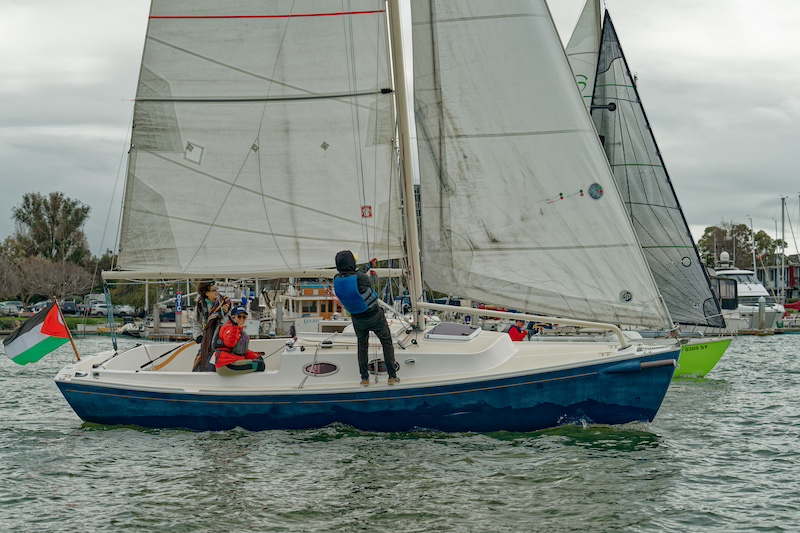
For Race 4 on February 16, the forecast said 1-5 knots with gusts to 7 knots. As the race committee readied the deck and watched the Estuary, they saw nary a flutter of flags. Marks were set, courses chosen, and the Coast Guard called, and still maybe 1 knot. So, a postponement was in order while we watched to see if a little more time would get us enough wind to start the race.
The start was at the end of the flood, and it would be ebbing during much of the race, with very small currents — a good thing with little to no wind. Ah, but after a 20-minute postponement, flags started to flutter — nothing big but enough to get the racing started.
There were 28 boats patiently waiting and ready to race. The RC called for a short course for all the fleets to get a race in and completed for everyone. It was crowded at the marks, but good racing, and after the leeward mark rounding, the ebb and the wind worked together and all had a nice final leg.
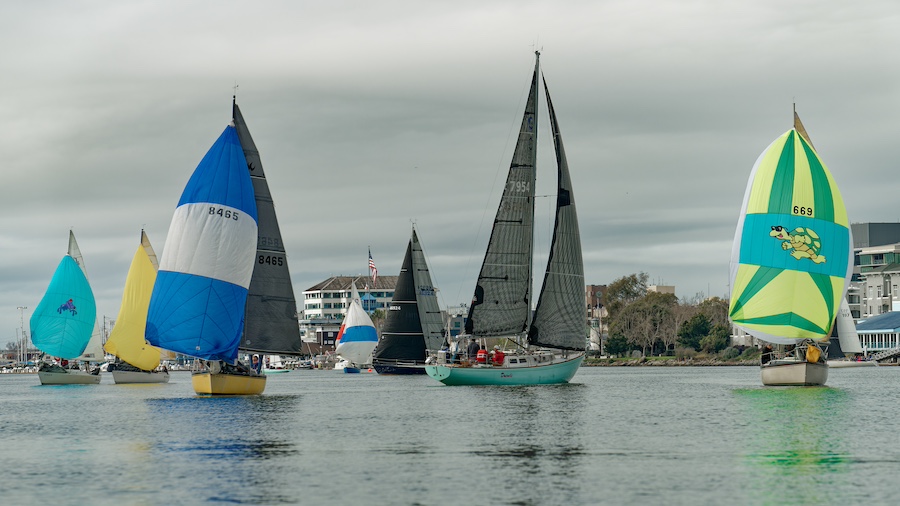
The OYC Race Speakers Series kicked off on January 19. Before Race 2, Kame Richards spoke about racing sails. The series continued on February 2, with Ryan Nelson of Rogue Rigging talking about tuning your rigging and rig inspection. A lot of good information was shared, broken parts inspected, and products, approaches and safety discussed. The third speaker was Mark Mines, bar pilot, giving a San Francisco Bar Pilot overview on March 16.
Next on the OYC calendar is the Sweet Sixteen Race Series, First Half. See www.oaklandyachtclub.net, and sign up for races at www.jibeset.net.
See more racing reports in the March Racing Sheet. The April magazine, with March race reports, comes out tomorrow. Pick one up at a distribution point near you.
The Resourceful Sailor and the Circus Bike
And now for something completely different … from our favorite sailing MacGyver, we bring you The Resourceful Sailor’s adventures aboard his Circus Bike.
My landlubber friends sometimes snickered at me when I rode my folding bike. I hope it’s the bike that was drawing the attention. When compared to a conventional one, the proportions were all wrong. The wheels were small, like on a BMX bike, but the frame was trying to be adult-sized with high-rise extensions for the handlebars and the seat. That’s why I’d taken to calling it the Circus Bike. I didn’t ride it around the hometown much, reserving it for trips aboard Sampaguita, in particular voyages throughout Puget Sound, the San Juans, the Gulf Islands, and the Sunshine Coast. It was a convenient tool, a time-saver, and good exercise and entertainment. If you are considering carrying a bicycle on board, I offer these stories with the Circus Bike as an account of possibilities.
Why did I buy a folding bike to carry aboard my boat?
When I purchased Sampaguita, a Pacific Seacraft Flicka 20, in 2013, the seller offered a folding bike and a Montgomery 7-11 dinghy with the sale. The bike was in excellent condition, and the dinghy had a sailing rig. I hadn’t considered having either before, but the price was right. I could sell them if they didn’t work out.
Now I have a bike, where do I put it?
Following the previous owner’s lead, I initially stored the Circus Bike lashed on the settee next to the companionway. I quickly grew tired of looking at it, and it took up valuable cabin space. If I forgot to lash it, it would crash onto the sole. After the second time, I’d had enough. A Flicka’s diminutive size limits the options, but since Sampaguita didn’t have an inboard motor, I wondered if the Circus Bike might fit into that engine space.

Huh? How do I do that?
Here is where it gets very builder-specific. Pacific Seacrafts have a removable cockpit sole held down with four knurled knobs. While this gives full access to the engine space from above, it is an awkward reach. Standing inside the cabin and leaning against the companionway ladder, facing aft, I could reach over the bridge and leverage my lower body off the bulkhead and ladder to lift the bike in and out. After trial and error, I found a way to angle in the Circus Bike. It took some shuffling around the other gear I stowed in there, but everything still fit. I added some padding to protect the contact spots.
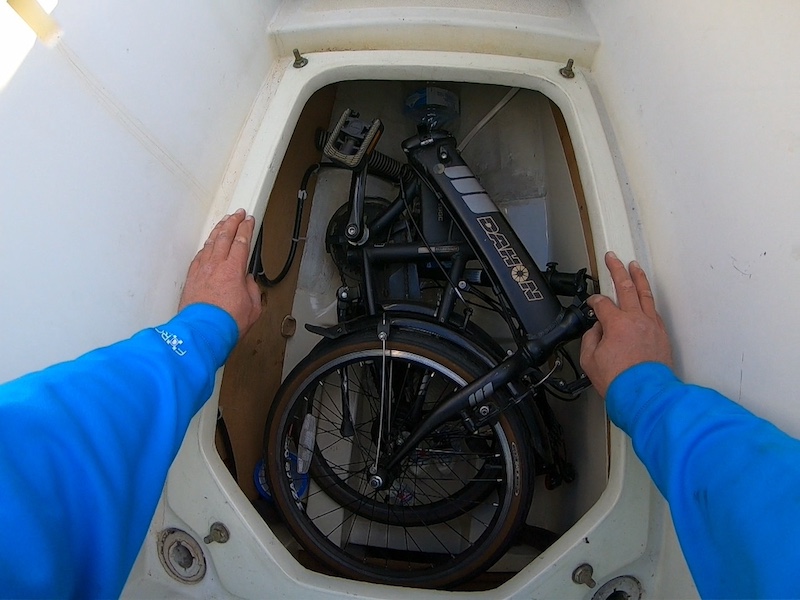
When did I use it?
Having a bike paid off when I was tied to a dock. Fetching gasoline for Sampaguita’s outboard with jerry cans could be simpler and faster than moving the boat to a fuel dock. Pumps aren’t always close, are sometimes broken, and sometimes are out of fuel. Grocery runs were also great. No cab fare and no waiting. For example, I stayed at the Orcas Island Yacht Club on the West Sound of Orcas Island, where there are no services. I rode the bike to East Sound, six miles away, for fuel and groceries. And the Orcas Island countryside is beautiful.
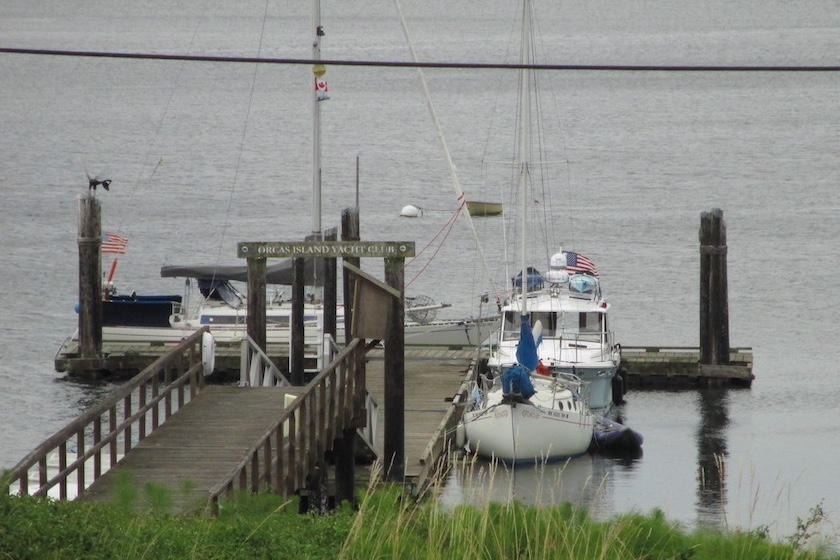
What else?
I needed to top off my propane tank before I headed up to Princess Louisa Inlet one summer. I had aimed to do this in Port Townsend, but the propane station was out of order. I waited until Nanaimo, but the closest filling station was two miles inland. I was informed taxis may consider a propane tank dangerous cargo and refuse service. Since everything on a Flicka is small, I had a 1.4-gallon, tall, slim Worthington tank. It fit in my backpack. I used the Circus Bike to get to the station and back. It felt a little dangerous, like riding a bike with a bomb on my back, but likely only marginally more dangerous than a car, and it worked great.
Is it only for work?
No, not at all. I have explored many islands and peninsulas on the Circus Bike: Lopez, San Juan, Orcas, Stuart, and South Pender islands, for example. While docked in Prevost Harbor on Stuart Island, I did a six-mile round trip to Turn Point Lighthouse. The bike did well, considering the dirt trail, washouts and hills. I wouldn’t have had time to make the trip without the bike.
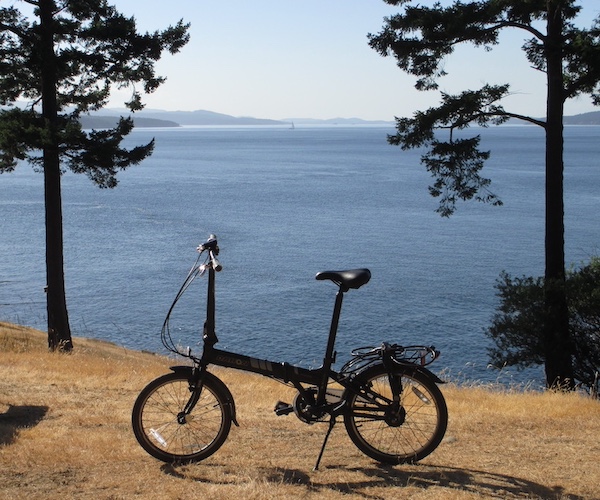
In Egmont, British Columbia, the bike first served for two gas runs to town. Back Eddy Resort’s gas pump, where I was staying, was broken. (I don’t need to make this stuff up.) I then rode most of the way to Skookumchuck Narrows to watch the kayakers ride the standing waves in the Sechelt tidal rapids — a seven-mile round trip. The Circus Bike got me to the rapids in time for the maximum flood and home for the sunset.
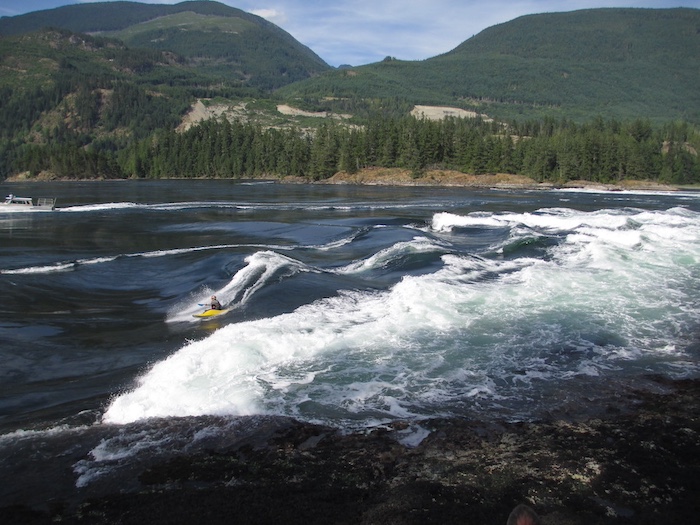
What about at anchor?
All of my bike experiences have been with Sampaguita moored to a dock. I used an inflatable kayak when at anchor. The kayak was stable, but transporting the bike felt insecure. I was nervous about it going into the water.
What about the Montgomery?
It was too big for long journeys with the Flicka. It always had to be towed, so I’d sold it to buy the kayak.
If you have a small boat and can find an acceptable place to store a bike aboard, it could expand your shoreside possibilities when cruising. Each boat will require its unique approach to storage, but that’s part of the fun of messing about. Whether it be for running errands or exploring, you will be able to travel farther and faster. The Circus Bike had a bike rack, so I could strap on a small jerry can or a box of groceries, and wear a backpack.
Folding bikes look a bit weak to an avid rider, but they are surprisingly strong. Since I reserved its use for cruising on Sampaguita, and as a backup for my regular, land-based bike, little maintenance was required. I did add a shim to one of the folding latches for a more secure fit, and kept the chain lubricated. Since I stored it inside, out of the elements, salt was not an issue.
Remember, keep your solutions prudent and safe, and have a blast.
Look Out for the Special April 1 Edition of ‘Lectronic Latitude
Working to a set schedule has its advantages — you know exactly what is expected of you, and when. But the repetition can become, well, repetitive, and every so often we try to shake things up a little. To keep us, and you, our readers, on our toes and pumping with excitement, we’ve decided to add a little zest to our weekly offerings.
Tomorrow we’re publishing a special April 1 edition of ‘Lectronic Latitude. We’re not going to tell you now what’s coming up, and we’re not going to send you a notification to say, “It’s here!” We’re going to trust that you’ll log on to your computer, phone or tablet and see for yourselves.
We will give you a little hint. You can expect aluminum foil, dryer lint, and styrofoam coolers.
Tune in tomorrow to get the details.
Oh, and on a different note, the April issue of Latitude 38 is also out tomorrow. We’ll share more on that in Wednesday’s ‘Lectronic Latitude.
Steering the Dream With Hydrovane
Hydrovane is your best crew member: an independent self-steering windvane and emergency rudder/steering system … ready to go!

